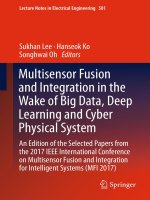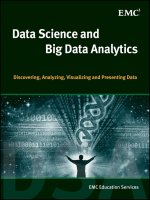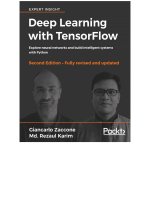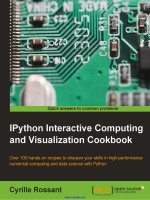Deep learning in Python Master Data Science and Machine Learning with modern neural networks written in python, theano, and tensorflow
Bạn đang xem bản rút gọn của tài liệu. Xem và tải ngay bản đầy đủ của tài liệu tại đây (667.68 KB, 104 trang )
<span class="text_page_counter">Trang 4</span><div class="page_container" data-page="4">
Experts in the field of Artificial Intelligence thought we were 10 years away from achieving a victory against a top professional Go player, but progress use the Python programming language, along with the numerical computing library Numpy. I will also show you in the later chapters how to build a deep networkusingTheanoandTensorFlow,whicharelibrariesbuiltspecificallyfor deeplearningandcanacceleratecomputationbytakingadvantageoftheGPU.
</div><span class="text_page_counter">Trang 5</span><div class="page_container" data-page="5"><i>because it automatically learns features. That means you don’t need to spend</i>
your time trying to come up with and test “kernels” or “interaction effects” -something only statisticians love to do. Instead, we will let the neural network learn these things for us. Each layer of the neural network learns a different abstraction than the previous layers. For example, in image classification, the first layer might learn different strokes, and in the next layer put the strokes together to learn shapes, and in the next layer put the shapes together to form facialfeatures,andinthenextlayerhaveahighlevelrepresentationoffaces.
Do you want a gentle introduction to this “dark art”, with practical code examples that you can try right away and apply to your own data? Then this
</div><span class="text_page_counter">Trang 6</span><div class="page_container" data-page="6">so no need to get scared about the machines taking over humanity. Currently neural networks are very good at performing singular tasks, like classifying
The brain is made up of neurons that talk to each other via electrical and chemical signals (hence the term, neural network). We do not differentiate
</div><span class="text_page_counter">Trang 7</span><div class="page_container" data-page="7">These connections between neurons have strengths. You may have heard the phrase, “neurons that fire together, wire together”, which is attributed to the
</div><span class="text_page_counter">Trang 8</span><div class="page_container" data-page="8">another neuron might cause a small increase in electrical potential at the 2nd
</div><span class="text_page_counter">Trang 12</span><div class="page_container" data-page="12">Wecallthe layerof z’sthe “hiddenlayer”.Neural networkshave oneor more hidden layers. A neural network with more hidden layers would be called “deeper”.
“Deep learning” is somewhat of a buzzword. I have googled around about this topic, and it seems that the general consensus is that any neural network with oneormorehiddenlayersisconsidered“deep”.
</div><span class="text_page_counter">Trang 15</span><div class="page_container" data-page="15">Neurons have the ability when sending signals to other neurons, to send an “excitatory” or “inhibitory” signal. As you might have guessed, excitatory connections produce action potentials, while inhibitory connections inhibit
</div><span class="text_page_counter">Trang 17</span><div class="page_container" data-page="17">examples in this book. is a great resource for this. I would recommend the MNIST dataset. If you want to do binary classification you’ll
</div><span class="text_page_counter">Trang 18</span><div class="page_container" data-page="18">Thus X is an N x D matrix, where N = number of samples and D = the dimensionality of each input. For MNIST, D = 784 = 28 x 28, because the
So for the MNIST example you would transform Y into an indicator matrix (a matrix of 0s and 1s) where Y_indicator is an N x K matrix, where again N = number of samples and K = number of classes in the output. For MNIST of
</div><span class="text_page_counter">Trang 20</span><div class="page_container" data-page="20">Unlike biological neural networks, where any one neuron can be connected to any other neuron, artificial neural networks have a very specific structure. In
</div><span class="text_page_counter">Trang 30</span><div class="page_container" data-page="30">Of course, the outputs here are not very useful because they are randomly initialized. What we would like to do is determine the best W and V so that
</div><span class="text_page_counter">Trang 41</span><div class="page_container" data-page="41">Before we start looking at Theano and TensorFlow, I want you to get a neural network set up with just pure Numpy and Python. Assuming you’ve went
</div><span class="text_page_counter">Trang 43</span><div class="page_container" data-page="43">entire dataset at the same time. Refer back to chapter 2, when I talked about repetition in biological analogies. We are just repeatedly showing the neural networkthesamesamplesagainandagain.
</div><span class="text_page_counter">Trang 46</span><div class="page_container" data-page="46">objects based on the number of dimensions of the object. For example, a 0-dimensional object is a scalar, a 1-0-dimensional object is a vector, a
</div><span class="text_page_counter">Trang 50</span><div class="page_container" data-page="50">One of the biggest advantages of Theano is that it links all these variables up into a graph and can use that structure to calculate gradients for you using the
</div><span class="text_page_counter">Trang 51</span><div class="page_container" data-page="51">Now let’s create a Theano train function. We’re going to add a new argument called the updates argument. It takes in a list of tuples, and each tuple has 2
</div><span class="text_page_counter">Trang 52</span><div class="page_container" data-page="52">Notice that ‘x’ is not an input, it’s the thing we update. In later examples, the
</div><span class="text_page_counter">Trang 56</span><div class="page_container" data-page="56">that we hope that over a large number of samples that come from the same
</div><span class="text_page_counter">Trang 59</span><div class="page_container" data-page="59">TensorFlowisanewerlibrarythanTheanodevelopedbyGoogle.Itdoesalotof nice things for us like Theano does, like calculating gradients. In this first section we are going to cover basic functionality as we did with Theano
If you are on a Mac, you may need to disable “System Integrity Protection” (rootless) temporarily by booting into recovery mode, typing in csrutil disable,
</div><span class="text_page_counter">Trang 60</span><div class="page_container" data-page="60">With TensorFlow we have to specify the type (Theano variable = TensorFlow
</div><span class="text_page_counter">Trang 61</span><div class="page_container" data-page="61">Analogous to the last chapter we are going to optimize a quadratic in TensorFlow. Since you should already know how to calculate the answer by hand, this will help you reinforce your TensorFlow coding and feel more
</div><span class="text_page_counter">Trang 62</span><div class="page_container" data-page="62">This is the part that differs greatly from Theano. Not only does TensorFlow compute the gradient for you, it does the entire optimization for you, without youhavingtospecifytheparameterupdates.
</div><span class="text_page_counter">Trang 65</span><div class="page_container" data-page="65">function (that’s just how TensorFlow functions work). You don’t want to softmax this variable because you’d effectively end up softmax-ing twice. We
</div><span class="text_page_counter">Trang 66</span><div class="page_container" data-page="66">While these functions probably all seem unfamiliar and foreign, with enough consultation of the TensorFlow documentation, you will acclimate yourself to
</div><span class="text_page_counter">Trang 67</span><div class="page_container" data-page="67">Notice how, unlike Theano, I did not even have to specify a weight update expression! One could argue that it is sort of redundant since you are pretty much always going to use w += learning_rate*gradient. However, if you want different techniques like adaptive learning rates and momentum you are at the
</div><span class="text_page_counter">Trang 71</span><div class="page_container" data-page="71">Well, this is the field of programming. So you have to program. Take the equation, put it into your code, and watch it run. Compare its performance to
</div><span class="text_page_counter">Trang 73</span><div class="page_container" data-page="73">Momentum in gradient descent works like momentum in physics. If you were moving in a certain direction already, you will continue to move in that
</div><span class="text_page_counter">Trang 79</span><div class="page_container" data-page="79">The derivative of the absolute value function is constant on either side of 0. Therefore, even when your weights are small, the gradient remains the same, until you actually get to 0. There, the gradient is technically undefined, but we treat it as 0, so the weight ceases to move. Therefore, L1 regularization encourages “sparsity”, where the weights are encouraged to be 0. This is a common technique in linear regression, where statisticians are interested in a smallnumberofveryinfluentialeffects.
</div><span class="text_page_counter">Trang 80</span><div class="page_container" data-page="80">Stopping backpropagation early is another well-known old method of regularization. With so many parameters, you are bound to overfit. You may
</div><span class="text_page_counter">Trang 82</span><div class="page_container" data-page="82">Suppose the label for your image is “dog”. A dog in the center of your image should be classified as dog. As should a dog on the top right, or top left, or
</div><span class="text_page_counter">Trang 83</span><div class="page_container" data-page="83">Dropout is a new technique that has become very popular in the deep learning community due to its effectiveness. It is similar to noise injection, except that nowthenoiseisnotGaussian,butabinomialbitmask.
In other words, at every layer of the neural network, we simply multiply the nodes at that layer by a bitmask (array of 0s and 1s, of the same size as the
</div><span class="text_page_counter">Trang 87</span><div class="page_container" data-page="87">of deep learning. These are the fundamental skills that will be carried over to more complex neural networks, and these topics will be repeated again and
</div><span class="text_page_counter">Trang 88</span><div class="page_container" data-page="88">But there are other “optimization” functions that neural networks can train on, that don’t even need a label at all! This is called “unsupervised learning”, and algorithms like k-means clustering, Gaussian mixture models, and principal
Deep learning has also been successfully applied to reinforcement learning (which is rewards-based rather than trained on an error function), and that has been shown to be useful for playing video games like Flappy Bird and Super
</div><span class="text_page_counter">Trang 90</span><div class="page_container" data-page="90">Send me an email at and let me know which of the above topics you’d be most interested in learning about in the future. I always
</div><span class="text_page_counter">Trang 96</span><div class="page_container" data-page="96">So what is the moral of this story? Knowing and understanding the method in this book - gradient descent a.k.a. backpropagation is absolutely essential to understandingdeeplearning.
</div><span class="text_page_counter">Trang 97</span><div class="page_container" data-page="97">There are instances where you don’t want to take the derivative anyway. The difficulty of taking derivatives in more complex networks is what held many
</div><span class="text_page_counter">Trang 98</span><div class="page_container" data-page="98">But good performance on benchmark datasets is not what makes you a competent deep learning researcher. Many papers get published where
</div><span class="text_page_counter">Trang 101</span><div class="page_container" data-page="101">In part 4 of my deep learning series, I take you through unsupervised deep learning methods. We study principal components analysis (PCA), t-SNE (jointly developed by the godfather of deep learning, Geoffrey Hinton), deep autoencoders, and restricted Boltzmann machines (RBMs). I demonstrate how unsupervised pretraining on a deep network with autoencoders and RBMs can Wouldyoulikeanintroductiontothebasicbuildingblockofneuralnetworks-logistic regression? In this course I teach the theory of Wouldyoulikeanintroductiontothebasicbuildingblockofneuralnetworks-logistic regression (our computational model of the neuron), and give you an in-depth look at binary
</div><span class="text_page_counter">Trang 102</span><div class="page_container" data-page="102">If you are interested in learning about how machine learning can be applied to language, text, and speech, you’ll want to check out my course on Natural
</div>








